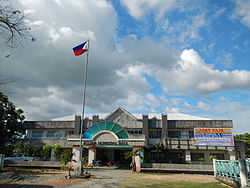Aliaga, officially the Municipality of Aliaga (Tagalog: Bayan ng Aliaga, Ilocano: Ili ti Aliaga), is a 2nd class municipality in the province of Nueva Ecija, Philippines. According to the 2020 census, it has a population of 70,363 people.[3]
Aliaga | |
|---|---|
| Municipality of Aliaga | |
 Municipal Hall | |
 Map of Nueva Ecija with Aliaga highlighted | |
Location within the Philippines | |
| Coordinates: 15°30′13″N 120°50′42″E / 15.5036°N 120.845°E | |
| Country | Philippines |
| Region | Central Luzon |
| Province | Nueva Ecija |
| District | 1st district |
| Founded | 1849 |
| Named for | Aliaga, Spain |
| Barangays | 26 (see Barangays) |
| Government | |
| • Type | Sangguniang Bayan |
| • Mayor | Gilbert Moreno |
| • Vice Mayor | Erwin Dyan D. Javaluyas |
| • Representative | Estrellita B. Suansing |
| • Municipal Council | Members |
| • Electorate | 49,634 voters (2022) |
| Area | |
| • Total | 90.04 km2 (34.76 sq mi) |
| Elevation | 26 m (85 ft) |
| Highest elevation | 43 m (141 ft) |
| Lowest elevation | 19 m (62 ft) |
| Population (2020 census)[3] | |
| • Total | 70,363 |
| • Density | 780/km2 (2,000/sq mi) |
| • Households | 16,853 |
| Demonyms | Aliagueño (Male), Aliagueña (Female), Aliaguenean |
| Economy | |
| • Income class | 2nd municipal income class |
| • Poverty incidence | 13.79 |
| • Revenue | ₱ 190.7 million (2020) |
| • Assets | ₱ 823.9 million (2020) |
| • Expenditure | ₱ 131.1 million (2020) |
| • Liabilities | ₱ 246.9 million (2020) |
| Service provider | |
| • Electricity | Nueva Ecija 2 Area 1 Electric Cooperative (NEECO 2 A1) |
| Time zone | UTC+8 (PST) |
| ZIP code | 3111 |
| PSGC | |
| IDD : area code | +63 (0)44 |
| Native languages | Tagalog Ilocano |
| Website | www |
History
Originally known as Pulong Bibit, Aliaga became a town on February 8, 1849, and named after the Spanish hometown of its first gobernadorcillo, Aniceto Ferry. Aliaga, along with Cabiao, Gapan, San Antonio and San Isidro were transferred from Pampanga to the province of Nueva Ecija in 1848. It once included the present-day municipalities of Zaragoza, Quezon, and Licab.[5] Kapampangans were the first settlers in the town, which was settled by the migrating Ilocano settlers.
Geography
It has a comparatively cool and healthful climate, and is situated about midway between the Pampanga Grande and the Pampanga Chico rivers, in a large and fertile valley. Historically, the principal products were mostly agricultural such as rice, tomato, eggplant, squash.[6]
Barangays
Aliaga is politically subdivided into 26 barangays. Each barangay consists of puroks and some have sitios.
- Betes
- Bibiclat
- Bucot
- La Purisima
- Magsaysay
- Macabucod
- Pantoc
- Poblacion Centro
- Poblacion East I
- Poblacion East II
- Poblacion West III
- Poblacion West IV
- San Carlos
- San Emiliano
- San Eustacio
- San Felipe Bata
- San Felipe Matanda
- San Juan
- San Pablo Bata
- San Pablo Matanda
- Santa Monica
- Santiago
- Santo Rosario
- Santo Tomas
- Sunson
- Umangan
Climate
| Climate data for Aliaga, Nueva Ecija | |||||||||||||
|---|---|---|---|---|---|---|---|---|---|---|---|---|---|
| Month | Jan | Feb | Mar | Apr | May | Jun | Jul | Aug | Sep | Oct | Nov | Dec | Year |
| Mean daily maximum °C (°F) | 29 (84) | 30 (86) | 32 (90) | 34 (93) | 33 (91) | 31 (88) | 30 (86) | 29 (84) | 30 (86) | 30 (86) | 30 (86) | 29 (84) | 31 (87) |
| Mean daily minimum °C (°F) | 19 (66) | 20 (68) | 20 (68) | 22 (72) | 24 (75) | 24 (75) | 24 (75) | 24 (75) | 24 (75) | 22 (72) | 21 (70) | 20 (68) | 22 (72) |
| Average precipitation mm (inches) | 4 (0.2) | 6 (0.2) | 7 (0.3) | 12 (0.5) | 61 (2.4) | 89 (3.5) | 96 (3.8) | 99 (3.9) | 81 (3.2) | 88 (3.5) | 37 (1.5) | 13 (0.5) | 593 (23.5) |
| Average rainy days | 2.5 | 3.0 | 4.1 | 6.3 | 15.8 | 19.4 | 22.5 | 21.6 | 20.1 | 17.5 | 9.6 | 4.0 | 146.4 |
| Source: Meteoblue[7] | |||||||||||||
Demographics
|
| |||||||||||||||||||||||||||||||||||||||||||||||||||
| Source: Philippine Statistics Authority[8][9][10][11] | ||||||||||||||||||||||||||||||||||||||||||||||||||||
Tagalog and Ilocano are the most important and the major languages of the municipality, minority speaks Kapampangan.
Economy
Poverty incidence of Aliaga
10 20 30 40 2006 30.50 2009 25.43 2012 18.99 2015 16.41 2018 6.71 2021 13.79 Source: Philippine Statistics Authority[12][13][14][15][16][17][18][19] |
Culture
The Taong Putik Festival is an annual festival held in the municipality on the feast day of Saint John the Baptist every 24th day of June. The religious festival is celebrated by the locals and devotees to pay homage to Saint John the Baptist by wearing costumes patterned from his attire. Devotees soak themselves in mud and cover their body with dried banana leaves and visit houses or ask people for alms in the form of candles or money to buy candles which is them offered to Saint John the Baptist.
Sister cities
- Cabanatuan, Nueva Ecija
References
External links



